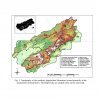Fountainguy97
Member
Wanted to do some digging around the NAO and what impacts it has on snowfall across the area.
We always say we need the -NAO but how much do we rely on the NAO for snowfall?
I basically took the periods from 1955 to present that were either +NAO dominated or -NAO dominated. I threw the between years into a couple "neutral groups."
The NAO graph is the averaged NAO index for JFM for each year (blue). Black is the 3 or 5 year average I believe.
Take a look for yourself! I thought it was pretty cool.
Seems that NAO doesn't make or break winter and it isn't the "fix all" for tons of snow BUT there is a clear increase in snowfall during -NAO winters.
The 2013-2019 period so far has been interesting. The mountains are seeing typical +NAO snowfall amounts but the rest of the area is seeing amounts more like -NAO winters. Could just be a couple heavy snow years as its only a 7 year average vs the other 15+ ones.
Temps are also colder for -NAO winters. Not too shocking there.

Another interested note about recent winters.
7 of the last 10 have been +NAO
3 of the last 10 have been -NAO/neutral

It sounds crazy but we have not seen a -NAO winter since 2012-2013 which was more neutral than anything. The last legit -NAO winter was way back in 2010-2011..
The recent 6 year run of +NAO winters has been impressive. This is the most impressive streak of +NAO winters ever. The other streak was 1989-1995 but there were a couple winters at neutral or -nao during that.
The question is what has made the NAO so regular at being + during winter? Is it just a luck of the draw or is there some driver that is forcing our NAO to be + during winters?
We always say we need the -NAO but how much do we rely on the NAO for snowfall?
I basically took the periods from 1955 to present that were either +NAO dominated or -NAO dominated. I threw the between years into a couple "neutral groups."
The NAO graph is the averaged NAO index for JFM for each year (blue). Black is the 3 or 5 year average I believe.
Take a look for yourself! I thought it was pretty cool.

Seems that NAO doesn't make or break winter and it isn't the "fix all" for tons of snow BUT there is a clear increase in snowfall during -NAO winters.
The 2013-2019 period so far has been interesting. The mountains are seeing typical +NAO snowfall amounts but the rest of the area is seeing amounts more like -NAO winters. Could just be a couple heavy snow years as its only a 7 year average vs the other 15+ ones.
Temps are also colder for -NAO winters. Not too shocking there.
Another interested note about recent winters.
7 of the last 10 have been +NAO
3 of the last 10 have been -NAO/neutral

It sounds crazy but we have not seen a -NAO winter since 2012-2013 which was more neutral than anything. The last legit -NAO winter was way back in 2010-2011..
The recent 6 year run of +NAO winters has been impressive. This is the most impressive streak of +NAO winters ever. The other streak was 1989-1995 but there were a couple winters at neutral or -nao during that.
The question is what has made the NAO so regular at being + during winter? Is it just a luck of the draw or is there some driver that is forcing our NAO to be + during winters?









